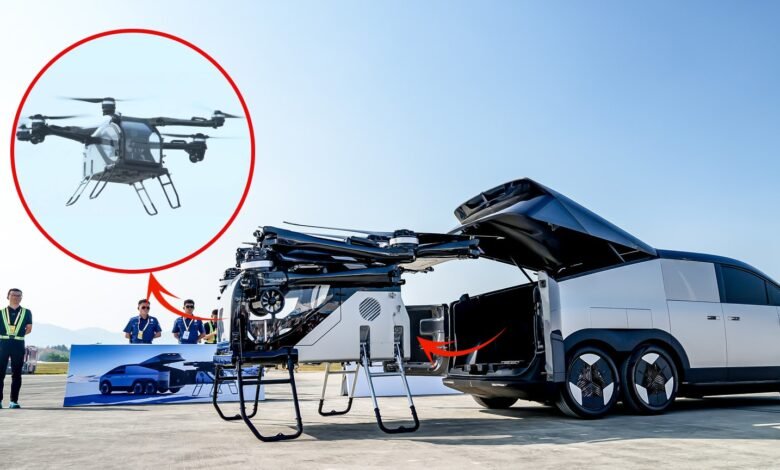XPeng Flying Car: A Glimpse Into the Future of Personal Air Travel

xpeng flying car The concept of flying cars has long been a fixture of science fiction, sparking imaginations and offering a glimpse of what the future might hold. However, one company, XPeng Motors, is turning that dream into a reality. With their development of a flying car, XPeng is not just aiming to revolutionize how we move; they are reshaping the future of transportation. The XPeng flying car is a breakthrough in urban mobility, combining cutting-edge technology, sustainability, and visionary design. This article will dive deep into what the XPeng flying car is, how it works, and its potential impact on the world.
Introduction: A New Era of Transportation
XPeng Motors, a Chinese electric vehicle (EV) manufacturer known for its innovative approach to the automotive industry, has set its sights on transforming the future of transportation. The XPeng flying car is poised to change the way we think about travel, combining the efficiency of electric vehicles with the versatility of aerial mobility. This ambitious project reflects the growing interest in flying cars and urban air mobility, two technologies that promise to redefine how we navigate crowded cities and sprawling landscapes.
The XPeng flying car stands out as one of the most exciting developments in this space, featuring the ability to take off and land vertically (VTOL) – a critical component for integrating flying vehicles into congested urban areas. Not only does this technology promise to ease the pressures of traffic congestion, but it could also offer a more sustainable and efficient mode of transportation. In this article, we will explore the key features, applications, and challenges associated with the XPeng flying car, and examine how this groundbreaking innovation could reshape the transportation industry.
Understanding the XPeng Flying Car
Overview of the Technology
The XPeng flying car is a sophisticated blend of automotive and aviation technology, designed to operate as both a car and a flying vehicle. The core of its design revolves around the use of electric propulsion, allowing for a quieter, more sustainable mode of flight compared to traditional combustion engines. The vehicle is equipped with vertical takeoff and landing (VTOL) capabilities, enabling it to lift off and land in confined spaces such as rooftops, parking lots, or designated vertiports. This design eliminates the need for long runways and offers immense flexibility in urban environments.
In addition to its VTOL function, the XPeng flying car is built with autonomous driving technology, which allows it to navigate both on the ground and in the air without requiring manual control. Through a combination of advanced sensors, cameras, and AI-driven algorithms, the vehicle can identify obstacles, follow designated flight paths, and ensure a smooth and safe ride for passengers. The electric motors powering the car are designed for efficiency and performance, offering an optimal balance between speed, range, and energy consumption.
One of the most innovative aspects of the XPeng flying car is its use of cutting-edge batteries designed to support both ground and aerial travel. These batteries are optimized for quick charging and long-lasting power, making the flying car a viable option for everyday use. Moreover, XPeng’s commitment to sustainable energy means that the vehicle is designed to minimize its carbon footprint, making it a more eco-friendly alternative to traditional modes of transportation.
Development Journey
XPeng’s venture into the flying car market is not a sudden leap but the culmination of years of research, development, and innovation. The company first announced its plans to enter the flying car sector in the early 2020s, making waves within the automotive and aerospace industries. Over the next few years, XPeng worked diligently to refine its design, conduct rigorous testing, and develop partnerships with aerospace experts to ensure the success of the project.
The company has collaborated with several key players in the aviation and electric vehicle sectors, including established aircraft manufacturers and technology firms specializing in autonomous systems. These partnerships have been critical in overcoming the technical challenges inherent in building a flying car, including weight distribution, battery efficiency, and safety protocols. XPeng’s flying car is not only the result of in-house innovation but also the outcome of a collaborative effort to push the boundaries of transportation technology.
One of the major milestones for XPeng came in 2023, when the company successfully demonstrated its flying car prototype in controlled environments. This event marked a significant step toward commercial viability, and the company has since focused on refining the vehicle’s design and securing necessary regulatory approvals. XPeng’s ultimate goal is to make flying cars accessible to the public within the next decade, transforming how we think about urban mobility.
Comparison with Competitors
While XPeng is making strides in the flying car market, it is not alone in this race. Several other companies, such as Joby Aviation, Terrafugia (a subsidiary of Geely, which also owns a stake in XPeng), and Urban Aeronautics, are also working on their own flying car projects. However, XPeng’s flying car stands out for its blend of automotive experience and aerospace engineering. The company’s expertise in electric vehicles and autonomous driving technology gives it a unique advantage in developing a flying car that is not only innovative but also practical and reliable.
What sets XPeng apart from some of its competitors is its focus on integrating flying cars into the urban landscape. While some flying car concepts are geared more toward personal aviation and rural or suburban applications, XPeng’s design emphasizes the need for compactness and flexibility in urban environments. The car’s ability to use both ground and airspace efficiently makes it a versatile solution for tackling urban congestion.
Potential Applications and Benefits
Urban Air Mobility
One of the most exciting applications of the XPeng flying car is its potential to revolutionize urban mobility. In cities around the world, traffic congestion is a growing problem, leading to longer commutes, increased pollution, and reduced productivity. Flying cars like XPeng’s could provide a much-needed solution by bypassing ground-level traffic altogether.
Imagine a scenario where commuters can take off from a rooftop parking lot, soar above traffic, and land at a vertiport near their destination. This kind of urban air mobility could drastically reduce travel times and make commuting a far more efficient experience. Additionally, flying cars could serve as a complementary mode of transportation to traditional vehicles, helping to reduce the pressure on overcrowded roads and public transportation systems.
The development of vertiports, designated takeoff and landing zones for flying cars, will be crucial in facilitating this transformation. These vertiports could be built on existing infrastructure such as airports, train stations, and commercial buildings, further integrating flying cars into everyday life.
Environmental Impact
One of the most significant benefits of XPeng’s flying car is its potential to reduce the environmental impact of transportation. Traditional cars are major contributors to air pollution, emitting carbon dioxide and other harmful gases. In contrast, electric vehicles, including flying cars, produce zero emissions during operation. By replacing fossil fuel-powered vehicles with electric flying cars, XPeng could help to reduce the carbon footprint of urban transportation.
Moreover, XPeng’s focus on sustainability extends beyond the vehicle itself. The company is working on creating a green ecosystem for urban air mobility, which includes energy-efficient charging infrastructure powered by renewable sources. As the world increasingly looks for ways to combat climate change, innovations like XPeng’s flying car offer a promising path toward cleaner, more sustainable transportation.
Economic and Social Impact
The introduction of flying cars could also have far-reaching economic and social effects. The rise of urban air mobility could give birth to new industries and create thousands of new jobs in areas such as aircraft maintenance, vertiport construction, and flying car piloting. As the technology matures, we may see an entirely new transportation sector emerge, with flying cars serving not only individuals but also businesses and governments.
Furthermore, flying cars have the potential to improve social equity by providing faster, more affordable access to transportation in underserved areas. In densely populated cities, where road traffic is a significant barrier to mobility, flying cars could offer a viable alternative, making it easier for people to reach work, education, and essential services.
Challenges and Criticisms
Regulatory Hurdles
Despite the excitement surrounding flying cars, significant challenges remain in terms of regulation. Airspace is a highly regulated environment, and introducing new vehicles that operate in the skies will require governments to update and revise existing aviation laws. XPeng and other companies in the flying car space will need to work closely with aviation authorities to ensure that their vehicles comply with safety standards and can coexist with traditional aircraft.
There are also challenges related to air traffic control. With the potential for thousands of flying cars in the air at any given time, new systems will need to be developed to manage these vehicles safely. This will require global cooperation and the development of new protocols for air navigation, flight paths, and emergency situations.
Infrastructure Requirements
For flying cars to become a mainstream transportation option, significant infrastructure changes will be needed. Vertiports must be constructed in key locations around cities, and new charging stations will need to be set up to power these vehicles. This presents both an opportunity and a challenge, as cities will need to adapt their infrastructure to accommodate flying cars without disrupting existing transportation systems. Additionally, developing the technology to enable seamless integration between ground-based and aerial vehicles will be a complex task that requires collaboration between different industries.
Technical and Safety Concerns
As with any new technology, safety is a major concern. Flying cars must undergo rigorous testing to ensure that they can operate safely in a variety of conditions. Battery life, flight stability, and emergency landing systems are just a few of the technical challenges that XPeng will need to address before their flying cars can be considered fully safe for public use. The public’s trust will be essential for the widespread adoption of flying cars, and XPeng will need to prioritize safety to build consumer confidence.
The Future of Flying Cars with XPeng
Looking to the future, XPeng’s flying car could be just the beginning of a broader transformation in urban mobility. The company envisions a future where flying cars are not only a mode of personal transportation but also a key component of smart cities and integrated transportation networks. By combining electric vehicles, autonomous technology, and aerial mobility, XPeng is leading the way in creating a new era of travel that could drastically change the way we live, work, and move around the world.
XPeng’s flying car is poised to play a key role in the transition to a more sustainable, efficient, and connected world. With advancements in technology, infrastructure, and regulation, the dream of flying cars could soon become a common reality.
Conclusion: xpeng flying car
The XPeng flying car represents a bold leap into the future of transportation. As urbanization increases and the world faces growing challenges related to traffic congestion, environmental sustainability, and limited infrastructure, flying cars offer a promising solution. XPeng’s dedication to innovation and sustainability places it at the forefront of this exciting new era. While significant challenges remain, the XPeng flying car is poised to play a crucial role in reshaping the transportation landscape for years to come.




